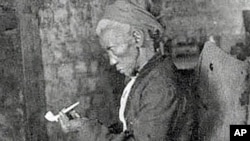The lives and rich traditions of descendants of West African slaves who live in southern coastal regions of the eastern United States are being showcased at a museum in Washington, DC. The exhibit at the Smithsonian's Anacostia Community Museum also profiles an African American scholar whose research first connected the Gullah-Geechee people with the language and culture of their ancestors. Our correspondent reports on efforts to educate people about the Gullah people while promoting preservation of their culture and traditions.
An estimated half a million Gullah people make their homes along coastal stretches of the Carolinas, Georgia and Florida.
Dorothy Browner-Hubler is a retired professor who uses song, dance and colorful stories to teach people about her upbringing in a Gullah community in South Carolina.
She says Gullah people are direct descendants of people from West Africa who were brought to America as slaves in the 17th and 18th centuries. They make up what many say is the most authentic African American community in the U.S.
"We are the only group of African Americans in the country who know where we are from and who have maintained our culture, history, our cooking traditions and many of our spiritual gifts that we wish to share with the rest of the world," said Browner-Hubler.
The Gullahs worked on rice plantations. Despite slavery they were able to pass along African cultural traditions such as boat building , basket making, and ritual songs.
The exhibit at the Smithsonian's Anacostia Museum focuses on African American scholar Lorenzo DowTurner. He did pioneering research in the 1930s on the origins of the Gullah people.
Many of the photographs on display were taken by Turner.
He discovered that the Gullah people retained and passed on their culture through music and storytelling.
Using early audio recording equipment, Turner captured and studied the voices of Gullah people speaking their own language. He rejected the notion that Gullah language was bad or broken English. He said it was a mix of African dialects, English and Creole.
Alcione Amos curated the Turner exhibit.
"I was first impacted by his intelligence, his ability to make the connections and to learn several languages in order to understand what he was researching," said Amos.
Richardo Williams came to see the exhibit. He grew up in the Gullah community on James Island in South Carolina.
"The main thing with this exhibit is that, folks who are not from the islands, they find that a lot of traditions and things that we still maintain and still do that their families were doing that. And they are now exploring more of their family tree," said Williams.
Tim Moore, another visitor, said the exhibit will ensure that future generations, especially African Americans, know something about their history.
"What this does is to wake people up to realize who they are," said Moore. "And what they are and what their ancestors are is who they are and that is very important."
That's especially true since, over the years, many of the elderly Gullah people have died. Others have been forced from their lands in part because of development which made the land so valuable and property taxes so high that few Gullahs could afford to stay.
Dorothy Hubler says she is determined to carry on the traditions of the Gullah people.
"We have represented the foundation of the black culture and in this day and time we are a dying culture and we must keep it alive," she said.
Many people agree and say the rich history of the Gullah people - some of the country's first black landowners - must be maintained for future generations.







